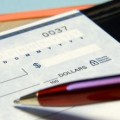Is the Check in the Mail? Probably Not.
There was a time not so long ago when every American child was taught penmanship in school. Drilled in each little nuance of cursive script, over and over and over again. We'd draw elegant loops and serifs, swirls and pigtails, capital letters and lower-case letters on the blackboard and on lined paper, until our fingers hurt. And as soon as that course was over, most of us slouched into block printing or a lazy scrawl. Every chance we got, we typed rather than hand-wrote notes, letters, school papers, grocery lists -- and e-mails when computers came along.
But there was always one last bastion of the handwritten word: the bank check. Time after time, we would scratch the name of the person who was getting the money, and the amount in numerals and words. Then we'd scribble our signature at the bottom of the check. But these days, bank checks are becoming an outdated relic. Thanks to credit cards and electronic payments, Americans are writing twenty-five percent fewer checks than we did ten years ago. So few, in fact, that the national bank, called the Federal Reserve, has closed more than half of its check-processing centers. In more and more retail stores, when presented with a check, the clerk runs it through a scanner that deducts the money instantly, then hands the check back to the customer. The merchant and the bank have no further use for it.
We still write our signatures on credit-card receipts and contracts and the like. And we still scrawl "I love you" on an occasional greeting card. But that's about it. So if you're looking for a good job in America, there are two we would not recommend: penmanship teacher and handwriting analyst.

